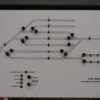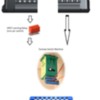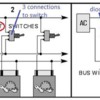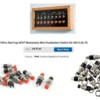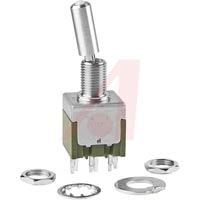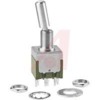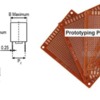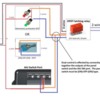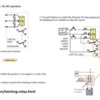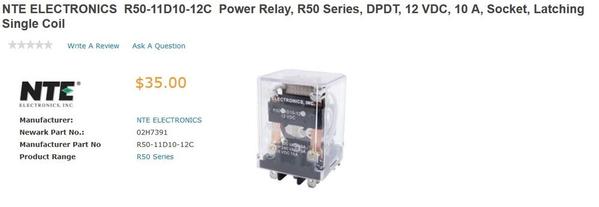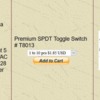Stan2004,
Would the switch you see here ( http://www.alliedelec.com/nkk-...2113tcfw01/70192198/ ) work in a panel for me? It is On-Off-On with red/green led?
No. That won't work for the Tortoises if there is simultaneous/concurrent control-ability from the panel and the AIU. The switch needs to be of the momentary-style just like the traditional spring-loaded, return-to-center lever switches that come with O-gauge turnouts. A common designation for this type of switch is (ON)-OFF-(ON) with the () indicating that it is a momentary contact only as long as you press the toggle up or down. If you use the ON-OFF-ON style and flip the lever to the upper or lower position, then power is continuously applied to the upper or lower circuit. This goes to your later point 4. below. Digging a bit deeper, the AIU Switch Ports essentially behave like a (ON)-OFF-(ON) switch in that when you press the Straight or Turnout icon it closes the respective internal relay for exactly 1/2 second to generate a momentary closure...and then returns to the idle or OFF state. So the (ON)-OFF-(ON) style allows two (or more for that matter) devices to control a circuit. In the case of the Tortoises the circuit being controlled is the latching relay where the momentary switch closure in the upper position "sets" the relay and a momentary switch closure in the lower position "resets" the relay. The relay is of the latching type so it stays in the set or reset position until commanded to the opposite position.
OK . . . . . new goals . . . .
1) I would like to control my sidings using on/off switches from a main panel. I would prefer switches that illuminate
Should be no problem finding illuminated switches for siding power. You only need SPST style switches or OFF-ON type using the nomenclature of above. Pretty much all illuminated switches these days use LEDs (instead of incandescent bulbs). Some will even have the necessary internal components to directly accept 12V DC to operate the LED. Others with just a bare LED will require an external 5 cent resistor to knock down the 12V DC to the few Volts that LEDs operate at.
2) I think I can do the latch relay thing and use the DCS/AIU approach. Stan, I actually think I can solder well enough to use the orange latched relay you show above. I cannot see how I would mount that anywhere near the Tortoise. How would I mount that latched relay?
I don't know if there's a "best" way. One could simply glue it to the Tortoise body and run the wires as needed. As it turns out that relay has its pins on a 0.1" grid pattern (2.54mm and 5.08mm apart). So you could use so-called project board which has drilled holes on a 0.1" grid and copper pads to solder the pins for a secure mount. You would probably mount 2 or 3 relays on one board to share 12V DC wiring. The project boards are relatively inexpensive - maybe $1 for the size shown.

3) I bought a dozen of those blue harnesses (don't know the exact name) so I do not have to solder to the Tortoise itself. The two DC 12 volt Walworts shown in Option #2 seem the best for me to handle. Don't know, however, where the latched relay would fit into the circuit in that diagram.
As it turns out if you want dual-control you need to use the Option 1 method with the DPDT latching relay performing the polarity-reversing duty of the DPDT switch in the Tortoise instructions. So you only need a single 12V DC wall-wart. I will draw a diagram once I catch up to your "new goals". 
4) I don't how I would wire to use either the DCS/AIU or the panel switch? For example, if the panel switch was set to green "straight," could I throw it to red "curved" with the AIU? If I did so, would there be confusion with the panel switch showing "green?"
Correct. For planning purposes it's best to separate the indicator (red-green LEDs) function from the switch function. If it turns out you find a switch which integrates the LED, that's great but you don't want to put the cart before the horse. This requires a bit of background plus a twist somewhat unique to the Tortoise. Background: illuminated switches come in two styles. One style has the light slaved to the position of the switch...so for example the light is always ON (or one color) when the lever is up, and the light is always OFF (or the other color) when the lever is down. The other style has an isolated light or lights that simply come to terminals on the switch and the user is responsible for activating lights accordingly. Obviously this latter style is what you want in the Tortoise situation with multiple controllers capable of setting the turnout direction.
The Tortoise also has an interesting property that allows you to hook up a bi-color (2-pin) LED inline with one of the two wires going to it. With no additional components (no resistor required) one or the other color LED (e.g., red or green) will turn on depending on the latching relay position (set or reset). It's a very useful feature that simplifies wiring. This is shown in the rightmost #4 circuit of the Tortoise instruction diagram. Again, once we are on the same page I can draw a detailed diagram.
And, as fate would have it, many illuminated toggle switches have bi-color LEDs inside with the 2-pins coming to terminals on the switch. So if you can find a suitable (ON)-OFF-(ON) style switch with an internal bi-color red/green LED, you can simply wire the 2-pins inline with the Tortoise wiring.
I realize that an illuminated toggle switch means only having to drill one hole for both the switch and the indicator. And, yes, they are really cool looking. But I'm guessing you'll have a hard time, or require a fat wallet, to find a suitable (ON)-OFF-(ON) illuminated switch with an internal isolated (not slaved) bi-color LED. In any event, if you can see your way to drilling two holes (one for switch, one for indicator) there are many 2-pin bi-color LEDs in the standard 3mm and 5mm diameters...say, 25-50 cents each. I think one of the guys commented he uses green-yellow (rather than red-green) bi-color LEDs on his panel. Again, more options if you can drill a 2nd hole. 

![]() Many thanks to all of you very patient folks walking me through the nether world of electronics. I am beginning to understand this and I hope that is a good thing.
Many thanks to all of you very patient folks walking me through the nether world of electronics. I am beginning to understand this and I hope that is a good thing. 
![]() (I assume one per switch) and that idea is not going to fly. I will throw the Tortoise machines with SPDT switches. So . . . . .
(I assume one per switch) and that idea is not going to fly. I will throw the Tortoise machines with SPDT switches. So . . . . . ![]()
![]() (another long story for another time !) and I will want to place the SPDT switches in the yard area not on the outside of the layout so, I guess, I will end up with more than one panel of SPDT switches depending on where on the layout the turnouts are located. So . . . . .
(another long story for another time !) and I will want to place the SPDT switches in the yard area not on the outside of the layout so, I guess, I will end up with more than one panel of SPDT switches depending on where on the layout the turnouts are located. So . . . . .










